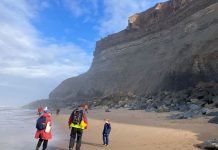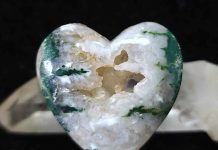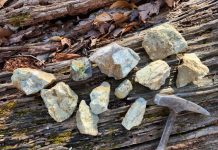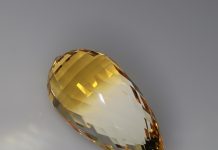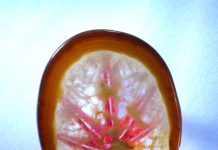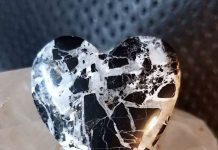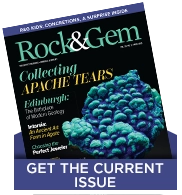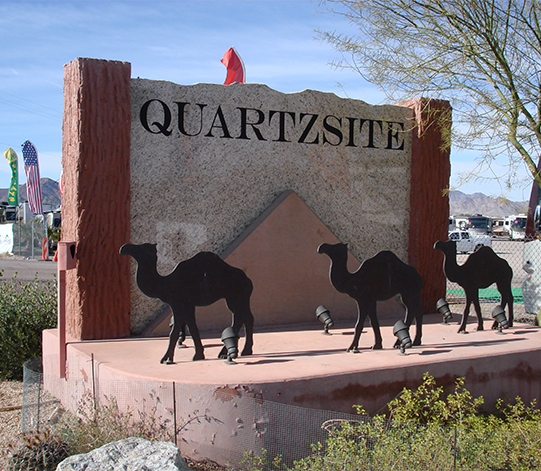
Quartzsite is located near the western border of Arizona. It’s at the crossroads of the east-west corridor between Phoenix and Los Angeles and the north-south passage, which follows the Colorado River toward Lake Havasu City to the north and Yuma to the south.
During the hot summer months, Quartzsite is a quiet place with about 4,000 year-round residents. That population explodes to over one million in the winter months making Quartzsite a spirited oasis in the desert and the destination for many rockhounds and lapidaries from every corner of the world. Some winter visitors, the snowbirds as the locals call them, come with their motorhomes and stay for 4-6 months, while others rush through the town for a few days.
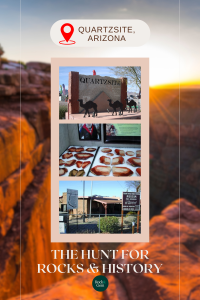
Winter Destination for Rockhounds
Quartzsite takes center stage in January, a couple of weeks before the big gem and mineral shows in Tucson. During the months of January and February, Arizona becomes a spotlight for all rockhounds, mineral collectors, gem enthusiasts, and jewelry lovers. Visitors come mainly for the gem and mineral shows, but they also enjoy side trips to museums, guided tours of copper mines, and explorations of the rugged landscapes that made the West famous.
The mild winter climate fosters this annual trek for many visitors. Although some years visitors have been surprised by nature’s fury with intense rainstorms in Quartzsite and Tucson that flood the tents and almost paralyze the shows. However, the traditional desert weather – sunny and warm days and clear and crisp nights are the norm.
Sometimes the night temperature drops below freezing, and the water in the tubs with slabs becomes ice-cold. This makes it almost impossible to put your hands in and sort. As many attendees have limited time, they are anxious to start their show routes early in the morning but soon find out that cold nights command a slow start in the morning for the outdoor vendors.
However, when the sun is shining, it fuels a laid-back, no-pressure atmosphere. Dealers sit under their tents waiting for customers, and shoppers stroll along the aisles, some walking leisurely, others briskly; often with their pets straddling along with them or inside unique strollers.
Miner, Dealer, Buyer Annual Reunion
Some vendors will go on to the subsequent Tucson shows to sell, but several of them will never go to the “big city.” There are miners and dealers that only come to Quartzsite, and buyers come back annually to see them. Many enjoy the free admission to all shows, the free no-hassle parking, and no need for trade registration.
About 2,000 vendors go to Quartzsite every year to sell rocks, minerals, gemstones, fossils and jewelry. Setting up outside is not easy for the dealers. Besides the unpredictable weather, dust covers everything and it is a daily, never-ending chore to keep the bins and displays clean. Vendors also have to secure their merchandise, tables, and tents every night, not only against theft but primarily against potential rain or wind damage.
Altogether there are about 10 shows in Quartzsite from late December to late February. But the main event that brings the most visitors into town is the Annual QIA Pow-Wow (the Quartzsite Improvement Association- the equivalent of a gem & mineral society — http://www.qiaarizona.org/PowWow.html).
Taking In the QIA Pow-Wow
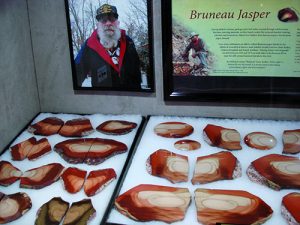
Besides the many vendors at this show (some are indoors but the vast majority are outside) visitors can expect to see exhibit showcases, always filled with wonderful private collections. The specimens are often unique and some are available for sale. A visit to the QIA Pow-Wow will be unforgettable. Even the short ride from the parking lot to the show is done in a unique carriage: a tractor-pulled wagon, courtesy of QIA. If you have time, field trip attire and tools, you can join the club for special rockhounding trips.
At the show, there are stacks of rock boulders, huge carvings, whole logs of petrified wood, and heaps of reconstituted turquoise. Sorting through piles of lapidary rough materials and slabs, of all types can easily take days. The quantity of these items, resting on the ground or on tables buckling under their weight, is mind-boggling! Finished jewelry, beads, and cabochons of every quality and style are everywhere. New and used lapidary equipment and tools are also offered by several dealers.
Just ahead of the QIA Pow-Wow is another exciting event in the Desert Gardens Gem, Mineral & Jewelry Show. There is always a considerable number of lapidary rough and slabs offered.
Quartzsite Show – Plan Ahead
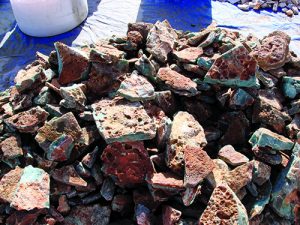
It is always a good idea to plan your itinerary ahead of your travel. Think about what you want to buy, the shows you want to attend, and plan your days accordingly. As the vast majority of the Quartzsite shows are outdoors, it is important it is to wear comfortable shoes, a hat and sunscreen, carry water and take breaks. Be prepared for cool, cold, colder or warm weather. That’s the desert in the winter. Be prepared to walk a lot of miles in the dusty aisles of the shows.
Also remember to keep detailed notes of what you are looking at or buying – which show, what item, what price, which dealer, what booth number, what day. At the end of the day or after a few days, it all becomes a blur, and if you want to go back and visit a dealer or order from them at a later date, those notes will be your life savers.
Quick Tip: Always check the show’s policy and ask for permission before you take photos of booths, merchandise and dealers.
Quartzsite Show – Buying Tips
Even though the shows in Quartzsite do not require a trade license to enter, if you own a business, it is always a good practice to bring your Business License or Tax ID Certificate. Not to mention, it helps to have many business cards and money in different forms as you may encounter different demands and deals.
Finally, have patience. If you are coming in at peak time, traffic on the Interstate exit ramps can be a gridlock, as there are only stop signs on the bridges. Lots of patience is also required when waiting about an hour for dinner at the few restaurants in town.
Quartzsite Landmarks
Coming into the town of Quartzsite from all entrances visitors are welcomed by the artistic town signs that offer a glimpse of the town’s history. The pyramid and camels have become iconic symbols for the town, reflecting the story of a camel driver who brought camels into the American desert.
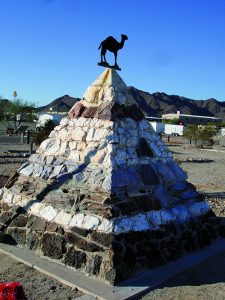
The “Hi Jolly” monument in the middle of town, dedicated by the Governor of Arizona in 1835, is a unique pyramid monument with a copper camel on the top that marks the gravesite of a camel driver for the U.S. Army Corps named Philip Tedro, or Hadji Ali, known by his anglicized name Hi Jolly. After the camel experiment was abandoned in 1861, he became a prospector and moved to Quartzsite where he married, and died penniless in 1902 at the age of 75.
Although Quartzsite was not a mining town, it was surrounded by many mining camps. In search of placer gold, hundreds of individual prospectors swamped the areas around Quartzsite in the 1860s and later.
At the time, water was a precious commodity and was hauled and delivered to the mines for a hefty price of $1 to $5 per barrel. Miners prospected mostly for gold but also for silver, kyanite, copper and lead. The 1864 census, the first one in the territory of Arizona, showed one out of every four residents reported their profession as miner or prospector.
Exploring Arizona’s Early Gold Mining
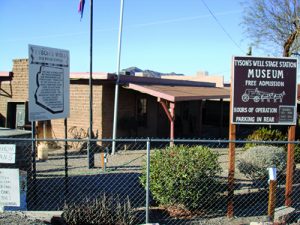
Tyson’s Well Stage Station Museum is located at 161 Main Street, steps away from the QIA Pow-Wow show.
The Tyson’s Well Stage Station Museum is housed in the original adobe stagecoach station built in 1866 by Charles Tyson. The station served as an important watering stop for the stagecoaches and freighters carrying mining equipment and supplies to the mines and the army from the river port at Ehrenberg on the Colorado River. Miners came up the Colorado River in steamboats and either stayed in Arizona or crossed over into California heading to the gold fields. The stop provided good water and “crude” passenger accommodations.
The Station even housed the post office from 1893 until 1895. For several years it was the town’s grocery store, and lodging and food source for the local saloons. Around 1900 it became the Oasis Hotel, but over the years it was neglected. That is until 1972 when the Rice family donated the lot with the Stage Station for a museum to be built. After extensive building restoration, the museum opened in 1980. It is operated by the Quartzsite Historical Society.
Quartzsite – Celebrating Heritage & History
A wealth of information is available at a new exhibit about all the mines of the area — The Cinnabar Mine, 10 miles south of Quartzsite produced quicksilver ore, which is valuable because gold and silver would adhere to it. The Copper Bottom Mine was 10 miles southwest of Quartzsite in the Cunningham Mountains. The Farrar Gulch Mine, 10 miles west of Quartzsite, was allegedly one of the richest placer gold mines. One nugget found there weighed 47 ½ pounds. Over $4 million in metal was dug out from the King of Arizona Mine (KOFA), operating from 1896-1910. The mine was so rich, that the mill had to be stopped every few hours to remove the gold from the plates.
More photos and information are exhibited about the Goodenough Mine, Mariquita, Moon Mountain, Gold Nugget mines, Bonanza Mine, Castle Dome Mining District and the Cienega District. An area map of historical mines shows 29 mines around Quartzsite. The extensive photographic record of the mines draws the visitor into the area’s history of sweat, tears, successes, and failures of mining gold, lead, and mercury.
There is no admission fee to the Tyson’s Well Stage Station Museum, although donations are always appreciated. The museum is open from November through March 10 a.m. to 4 p.m.
This story about Quartzsite, Arizona, previously appeared in Rock & Gem magazine. Click here to subscribe. Story and photos by Helen Serras-Herman.



